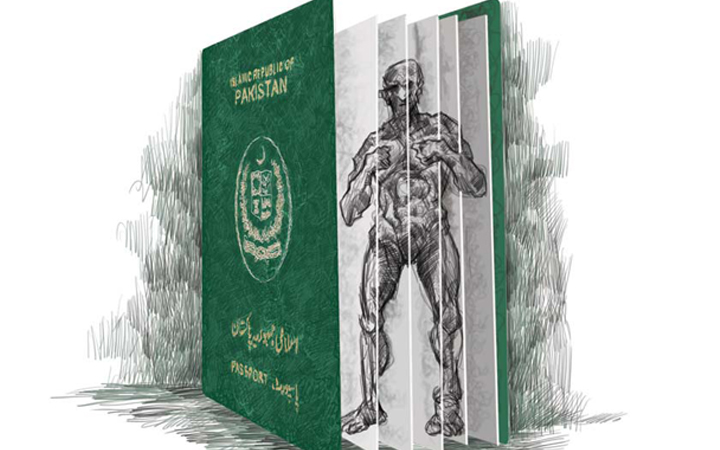Does a former militant have a way back? Is he allowed to have one?
A man who entered the Indian territory via Nepal from Pakistan administered Kashmir with his wife and daughter in tow, in March 2013, stands accused of being part of a terror plot as a supposed member of a fidayeen squad that was readying to attack Delhi during the festival of Holi. The Delhi police which arrested Liyaqat Shah, has been unable to explain several lacunae in its story – from the questions related to the indicted man’s family members, to the hotel where ammunition was found dumped by Liyaqat’s alleged accomplice, who, interestingly also left the key at the manager’s desk.
Jammu and Kashmir police has admitted that it knew about Liyaqat Shah’s arrival as part of an amnesty policy Jammu and Kashmir government announced and okayed two years back, for the benefit of those youth who went across the Line of Control (LoC) after 1989 to seek arms training but are not involved in any cases, and no longer with any militant organization. Even as the chief minister endorsed the same, he decided to prod the Centre to hand over Liyaqat’s case to the National Investigation Agency (NIA).
Who is Liyaqat Shah? Was he a fidayeen who decided to walk out of Nepal with his wife and daughter to blow himself up in Delhi? Or was he just a man fed up of militant groups and socio-political atmosphere across the border? Jammu and Kashmir government had him in his list of returnees and was aware of his return on the exact day and time. Is it so unsure of its own policy that instead of taking a stand and contesting the claims of Delhi police based on what appears to be a frivolous story, it decided to hand over the case to NIA?
The NIA is not an independent body. It is a central organization, created in the aftermath of Mumbai 26/11 attacks, created to fulfill the need for having a centralised authority to check terrorism across the country. Ever since it has cracked the cases of 26/11, Samjhauta and the Mecca blast, much to the disgust of the Hindu right wing that stands nailed in some of these cases, even though the real headway into their role was made much earlier, by ATS Maharashtra in Nanded and Malegaon blasts. But such a performance does not guarantee an unpartisan credibility. When it comes to Kashmir and Kashmiris, the most credible of central or quasi-autonomous agencies are known to be biased.
Incidentally, the performance of the NIA so far has been a political brownie point for the ruling UPA government. That the retiring chief of NIA is now being gifted a membership of National Human Rights Commission by the government, which he does not qualify for, further adds to the doubts about the NIA’s credibility.
“Jammu and Kashmir government asserts that it has received over 1000 applications under the policy and the green signal for return is given only after completely screening their cases and ensuring that they are not involved in any militant group. By last year 500 such applications had already been cleared and over 250 persons returned.”
While the Liyaqat Shah story remains mired in mystery, the case may also impact prospective beneficiaries of the amnesty policy. Already majority of those who have availed the benefits of this policy in the last one year are yet to be settled and still face various forms of harassment, revealing the flaws in the policy; both in its concept and execution. Though the policy has been criticized by the likes of BJP and Sangh Parivar for welcoming former militants, there is little one can find objectionable in the idea of rehabilitating those who wish to lay down arms and lead normal lives. After all, India already has a surrender policy in place for militants operating on this side of Jammu and Kashmir – a policy that was endorsed and more vociferously followed by the BJP led NDA government in New Delhi. So why should BJP now have a problem if the former militants sitting across the border are accounted for under a similar policy?
A more worrisome fact is the limits the government has set to this policy in terms of people it covers and the time period. The LoC has seen several migrations that have taken place from this side to that in the last six decades. (1965 was the biggest one after 1947). Half of the over lakh people returned within a year or two, following hectic efforts made by then chief minister G.M. Sadiq. After insurgency broke out in Jammu and Kashmir, several people again crossed the borders. All of them were not militants. Stories abound of repression and brutalities, of security agencies forcing them to cross or in some areas, Pakistan’s agencies forcibly taking them away to suit their own strategic concerns. There are also cases of youth who crossed the LoC to pick up the gun even before 1989. Such a category of people and innocent masses which fled from fear and could not return, are excluded from this policy.
The far bigger problem is the ambiguity of the policy that does not have any legal sanctity, even though the central government has backed it. Former union home minister P. Chidamabarm’s logic in defending the amnesty and surrender policy itself was fodder for controversy. Rather than viewing it within the paradigm of human approach and as a confidence building measure, a year ago, he chose to describe it ‘constitutional’ on grounds of owning the Pakistan Administered Kashmir territories. Following this logic, anybody crossing the LoC cannot be stopped. However, this is not the case in practice.
Jammu and Kashmir government asserts that it has received over 1000 applications under the policy and the green signal for return is given only after completely screening their cases and ensuring that they are not involved in any militant group. By last year 500 such applications had already been cleared and over 250 persons returned. They complained of harassment and ticklish problems in their resettlement with court cases pending against them, the legal status of their wives and children in limbo and their children being refused admission in schools. Statelessness is not simply restricted to the families as the courts even questioned the citizenship of atleast one of the returnees who crossed the Nepal border, maintaining that entry of a Pakistani citizen into Indian territory via Nepal border would amount to an illegal move. Such charges deflate the balloon of amnesty policy claims. Besides, some of those who crossed over and the other prospective beneficiaries of the scheme have also reportedly talked about their vulnerability with security and intelligence agencies on either side that forces them to engage in espionage.
A major technical flaw is the absence of a firmly grounded mechanism, whose basic requirement should be a clear agreement between the Indian and Pakistani governments. This is entirely missing even though all indications point to a tacit understanding between the two sides, paving way for the return. It is hardly unlikely that Pakistan’s agencies are totally ignorant of the fact that people are traversing either the LoC to go back to their homes or taking the longer route on Pakistani passports via Nepal. However, such hush-hush understanding has jeopardized the interests of people expected to gain from the policy. But were the interests of the people really paramount? Or is it simply a ploy to offer a picture of normalcy to the world through a symbolic display of return of those deemed as misguided youth, those who crossed the borders to join militant groups but are fed up with ‘jehad’, disgruntled in Pakistan administered Kashmir and want to lead normal lives? Or worse still, is it aimed simply at co-opting former militants, by agencies operating on either side of LoC, to act as spies and informers, and eventually forbidden to carry on with their normal lives?














